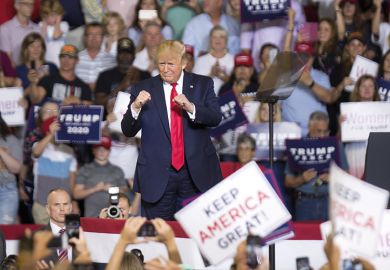Fears about foreign influence may reduce opportunities for universities
Under a president who was elected on a “Make America Great Again” platform, the danger of animus against foreigners in America is of great concern. Combined with genuine concern that the People’s Republic of China and other foreign powers are seeking to capitalise on America’s openness, transparency and commitment to the free flow of ideas in academic research, Trump’s rhetoric has led to a climate that may stifle scientific and medical breakthroughs in federally funded university programmes.
In February 2018, Federal Bureau of Investigation director Christopher Wray addressed the Senate Select Committee on Intelligence about the risks posed by foreign nations, and particularly China. He pointed to a “level of naïveté” in the academic sector about the threat presented by China’s “use of nontraditional collectors, especially in the academic setting, whether it’s professors, scientists, students, we see in almost every field office that the FBI has around the country”. He added that China is “exploiting the very open research and development environment that we have, which we all revere”. The “China threat”, stated director Wray, is “going to take a whole of society response by us”.
Following these comments, agencies such as the National Institutes of Health, the National Science Foundation and the Department of Education have all expressed similar concerns. They also have issued statements and new guidance regarding the obligations of federally funded grantees to disclose potential foreign influence on federally funded research, and have begun to investigate potential instances of misconduct. The concern expressed by US agencies is not limited to China, but also includes potential foreign influence from Russia, Iran, Saudi Arabia and other countries.
In August, the Department of Justice brought its first criminal case against a university professor at an American school, Dr Franklin Tao, for allegedly failing to disclose outside employment in China. Notably, and unlike prior indictments brought by the DOJ against university professors for grant fraud, this indictment was devoid of any allegation that the professor stole federal funds for his personal use, engaged in misuse of information gained through his research or otherwise failed to adequately conduct the research he was paid to perform. Rather, the indictment rested entirely on an allegation that, during an annual certification process, he failed to disclose a five-year employment contract with a talent programme sponsored by the Chinese government, which allegedly required the professor to be a “full-time” employee of Fuzhou University.
As a result of his alleged failure to disclose this information, the DOJ charged Tao with one count of wire fraud and three counts of programme fraud. Wire fraud is a criminal charge that punishes schemes to defraud that utilise wire transmissions (in this case, the allegedly false online certification by Tao). Programme fraud addresses the theft of funds or property provided through federal programmes. Tao faces up to 20 years in federal prison for wire fraud and up to 10 years for each count of programme fraud, as well as significant fines.
Such alleged failures to disclose foreign influence in connection with federally funded research grants may also lead to civil False Claims Act cases brought by the DOJ against individuals and universities. These civil actions, often initiated by whistleblowers, can result in significant payments to the government, along with hefty shares of those payments provided to the whistleblower. Because these cases are filed under seal by whistleblowers (and so not publicly available or immediately served on the defendant) and then investigated often for a period of years, it is not yet known how many have already been filed against universities and are under active investigation.
The significant financial threat that universities face from federal investigations and actions alleging improper foreign influence may reduce the opportunities provided to foreign faculty, teachers, students, researchers, postdocs and others.
Approximately 40 per cent of all American Nobel Prize winners since 2000 have been immigrants. The contributions that foreign-born researchers make to medical, scientific and other breakthroughs by American universities are enormous. Animus towards such individuals or hesitation to hire foreign researchers at American universities will cause tremendous harm to our long-term success as a nation – far greater harm than any theft of funds, ideas or intellectual property ever could.
Derek Adams, a former trial attorney with the Department of Justice's Civil Fraud Section, is a partner in Feldesman Tucker Leifer Fidell LLP’s Litigation and Government Investigations practice group.

The US is already building Trump’s wall
As an international student adviser and advocate for more than two decades, I’ve watched our country create barriers that place one of our largest exports – higher education – in serious jeopardy.
While Canada unveils plans to invest C$148 million (£120 million) towards international student enrolment, and the UK returns to pre-2012 policies by offering international students two-year post-study work visas, the US keeps stacking brick upon brick on to Trump’s wall under the guise of national security.
Some challenges that international students face have made the news. Many Americans will have read about port of entry officers inspecting electronic devices and about new questions on the visa application regarding social media use. We have heard about the rise in visa denials and students with valid documents turned away at the border. There is less public awareness of the many other increasing burdens that international students face.
Applicants for student visas must confirm their non-immigrant intent and plans to leave the US after they finish their academic programme. Visa renewals for those who travel home for a summer internship or a brief family visit require in-person interviews, long waiting times and background checks. Consulates and border officers put students through the wringer, inciting fear every time they cross the border. While the government seeks assurances that students will maintain connections with home, family members struggle to secure tourist visas to visit or attend events such as family weekends and commencements.
International students who have chosen the US must also navigate increasingly impermeable barriers to opportunities beyond the classroom. Most employers now screen out international student applicants, even for short-term internships. Because access to post-completion employment authorisation is so arduous, the unlikely prospect of honing an international student’s skills for future employability is simply not worth an employer’s time and money. Access to practical training authorisation (which allows international students to pursue a short-term job related to their major) is a benefit allowed by regulation, but increased scrutiny, higher fees and longer adjudication times make the application process and reporting requirements excessively burdensome for students, school officials and employers. The lack of clarity and potential for disparity between immigration regulations and labour laws makes it risky for students to volunteer off campus, threatening previously celebrated opportunities for soft diplomacy, community engagement and cultural exchange.
International students have also been hit by government agencies with increased financial burdens and extended adjudication times. The required Student and Exchange Visitor Information System fee, established in 2004, rose this past year from $200 to $350. The visa application fee is $160, and waiting times for appointments and the likelihood of a security review have both increased – placing the enrolment timeline at risk. The application fee for Optional Practical Training (the post-completion employment benefit) is up to $410. Unlike their US peers, non-resident taxpayers encounter front-end tax withholdings on grants, fellowships and prizes, and, under the 2018 tax law, lost access to the $4,050 personal exemption (which previously allowed tax-free earnings up to that amount).
Another significant challenge is the lack of flexibility if mistakes are made. An international student who accidentally exceeds the 20-hour on-campus work limit; fails a course (or needs a medical leave) in their final semester; or commits a misdemeanour, will quickly come face to face with a regulatory wall and limited options to rectify the error. They might lose access to practical training benefits or discover (at the border) that their visa has been revoked; a minor mistake can result in termination of their lawful status. Students who are misadvised or uninformed can easily violate their status and begin accruing days of unlawful presence, which can result in a bar against re-entry for three or 10 years.
An evolving issue is the burden of institutional compliance laid at the door of the academy. While some universities rely on international students for tuition dollars, many also dedicate significant financial aid to this cohort because enrolling a diverse student body enhances our educational mission. Yet the attention of international student and scholar advisers has been hijacked by the demands of complying with the Student and Exchange Visitor Program and advising on the regulations. Institutional responsibilities begin before students matriculate (for example, verifying every student’s funding, to prevent reliance on our nation’s financial security net). Compliance responsibilities are significant throughout the student’s enrolment and last for one to three years after they graduate for alumni who remain in the US for post-completion practical training. Practitioners who have not established a relationship with an immigration attorney risk the safety of their students and their institution. This transformation of the profession carries significant staffing and budgetary implications for schools that aspire to be international-student-friendly.
US higher education often celebrates our commitment to access, but this is increasingly at risk for international students. We set up roadblocks, take their money and then tell them to pack their bags and leave. The good news is that only some of these challenges are based on changes in the law: many recent nationalistic efforts to “deny, delay, and discourage” (to quote immigration attorney David Ware) have been implemented through the discretionary actions of government officials and adjudicators. In addition, the economic impact of discouraging international student enrolment has not gone unnoticed, and immigration reform is a clear priority for most presidential contenders. Institutions across the country will continue to value international students, and advisers will continue to prioritise the slogan #YouAreWelcomeHere. And, of course, we will vote.
Karen Edwards is associate dean and director of international student affairs and designated school official at Grinnell College in Iowa.
Open doors are the key to international understanding
The United States is cutting itself off from a vital source of knowledge through its unfriendliness towards Iranian students.
In recent weeks, we have seen 20 such students, who had gained admission to US universities and held valid visas, barred from entering the country just as they were poised to begin graduate studies this autumn. Although this first and foremost hurts them and their educational aspirations, it also deprives thousands of American students of the opportunity to learn first hand about a country with which the US has a complicated and difficult relationship. This is especially important because Iran is one of the few countries in the world where American students themselves are not able to study (even those wanting to learn Farsi are likely to go to a neighbouring country such as Tajikistan), so the only way for them to learn about Iran is to have Iranian students study side by side with them in class.
The growing distrust of Iranian students in the US was evident first in the so-called travel bans on Iranians and those from certain other countries which, despite including an exception for students, still make it very difficult for them to come to the US because of enhanced screening and extreme vetting. This latest round of restrictions on entry makes it hard to believe that such students were once the largest group of international students from any country, reaching a peak of 51,300 in 1979, exactly 40 years ago, but then plummeting soon after. Despite some modest recovery in the previous decade, their numbers have once again declined and the latest data from the State Department shows that just 1,433 Iranian students – 56 per cent fewer than four years ago – were issued visas in 2018. The cost to the education of American minds, classrooms and campuses is incalculable.
I know first hand about the learning and education that come from international exposure as a student. When I was growing up in India, my understanding of Iran was rooted in the histories of South Asia, romanticised and airbrushed with nostalgia but not grounded in contemporary political and national realities. The first Iranians I ever met were Taufiq and Fereshteh, graduate students who had arrived in the city of Bhopal in 1981 and were learning English from my mother, a professor of English at the local university. It was soon after the Iranian Revolution, when much of the country’s westernised and privileged elite fled, heading not only to the West but also to neighbouring countries such as India, which has shared a long history with Persia. What left an impression on my 11-year-old mind was how Fereshteh and Taufiq welcomed us into their home and community.
Arriving in the US as an international student in 1992, I realised that Americans felt very differently about Iran from Indians back home. Iranians were discussed either in hushed tones or with palpable anger, and Iran was regarded as a place of darkness, extremism and ignorance. This was not the Iran I knew. To me, Iran was Persia, a land of art and poetry, where Isfahan was to the Indian subcontinent what Paris was to the West, and where Farsi was the equivalent of Latin – a language of culture and refinement, the poetic language of Hafez in Persia and Mirza Ghalib in India.
Through my American classmates I learned about the Iran hostage crisis and began to better understand the deep anger and resentment of Americans towards Iran. I would not have discovered any of this if I hadn’t come to the US as an international student. For the first time in my life I was exposed to different histories and alternative ways of thinking, allowing me to develop a more nuanced understanding of the relationships between countries and their people. The experience helped me understand not only Americans but also the contexts, histories and perceptions that students from all over the globe bring to the US, where colleges and universities today host 1.09 million students from more than 220 countries.
This type of mutual understanding is possible only if the US keeps its doors open to all students, but especially to those from countries such as Iran whose histories and cultures have been shrouded in mystery and are often misunderstood. Some will argue that Iranian students are a threat to national security. But such students are already banned from pursuing certain sensitive fields of study relating to energy and nuclear engineering, and are already vetted extensively, much more than other visitors coming to the US. It is precisely at times such as these, with escalating political tensions and a breakdown of traditional diplomacy, that educational exchange remains the best means for American citizens to maintain friendly relations with the citizens of other countries. While we need to continue sending more American students abroad to learn about the rest of the world, let us not close the door to those who come here to educate themselves and their American classmates.
Rajika Bhandari is an expert on global student mobility trends and is completing a book on the international student experience. Until recently, she led the Institute of International Education's research on international students.
POSTSCRIPT:
Print headline: Navigating a hostile environment
Register to continue
Why register?
- Registration is free and only takes a moment
- Once registered, you can read 3 articles a month
- Sign up for our newsletter
Subscribe
Or subscribe for unlimited access to:
- Unlimited access to news, views, insights & reviews
- Digital editions
- Digital access to THE’s university and college rankings analysis
Already registered or a current subscriber?








